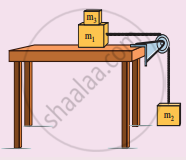Advertisements
Advertisements
Question
State the empirical laws of static and kinetic friction.
Solution
The empirical laws of friction are:
- Friction is independent of the surface of contact.
- The coefficient of kinetic friction is less than the coefficient of static friction.
- The direction of frictional force is always opposite to the motion of one body over the other.
- Frictional force always acts on the object parallel to the surface on which the object is placed,
- The magnitude of frictional force between any two bodies in contact is directly proportional to the normal reaction between them.
APPEARS IN
RELATED QUESTIONS
A long stick rests on the surface. A person standing 10 m away from the stick. With what minimum speed an object of mass 0.5 kg should he has thrown so that it hits the stick. (Assume the coefficient of kinetic friction is 0.7).
Two masses m1 and m2 are connected with a string passing over a frictionless pulley fixed at the comer of the table as shown in the figure. The coefficient of static friction of mass m1 with the table is µs Calculate the minimum mass m3 that may be placed on m1 to prevent it from sliding. Check if m1 = 15 kg, m2 = 10 kg, m3 = 25 and µs = 0.2.

A uniform metal chain is placed on a rough table such that one end of the chain hangs down over the edge of the table. When two-thirds of its chain length hangs over the edge the chain start sliding. Then the coefficient of static friction is:
A uniform chain of length 3 metres and mass 3 kg overhangs a smooth table with 2 metres laying on the table. If k is the kinetic energy of the chain in joule as it completely slips off the table, then the value of k is ______.
(Take g = 10 m/s2)
If a body of mass m is moving on a rough horizontal surface of coefficient of kinetic friction µ, the net resultant force exerted by surface on the body is ______.
A 40 kg wooden crate is being pushed across a wooden floor with a force of 160 N. If µk = 0.3, the acceleration of the crate is ______ m/s2. (g = 10 m/s2}
A block of mass m is pulled by a constant power P placed on a rough horizontal plane. The friction co-efficient between the block and the surface is µ. Maximum velocity of the block will be:
Block A has a mass of 2 kg and block B has 20 kg. If the coefficient of kinetic friction between block B and the horizontal surface is 0.1, and B is accelerating towards the right with a = 2 m/s2, then the mass of the block C will be ______.
(g = 10 m/s2)

A chain of mass 'M' and length 'L' is put on a rough horizontal surface and is pulled by constant horizontal force 'F' as shown in the figure. The velocity of the chain as it turns completely ______.
(Coefficient of friction = μ)

The coefficient of static friction between a car's tires and a level road is 0.80. If the car is to be stopped in a maximum time of 3.0 s, its speed cannot exceed.
